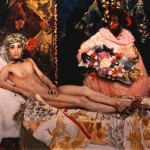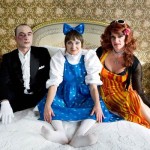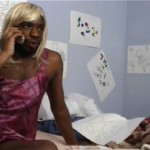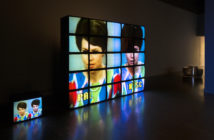Virtuoso Illusion: Cross-Dressing and the New Media Avant-Garde is the latest curatorial project by Michael Rush, and his first since leaving the Rose Art Museum. Big RED editor James Nadeau spoke with Rush about the show, the new media avant-garde and gender.
JN: The first thing I wanted to ask was about the origins of the exhibition. Was this an idea that has percolated for some time? Was this in the works prior to the events at the Rose?
MR: The idea came from looking. I have been struck for at least a year now how several of the most interesting artists working in video were also using cross dressing as a part of their work. It wasn't an issue I was looking for… it was something that showed itself to me. It was this observation that led me to contextualize the work with important historical referents.
JN: As a follow up: The reason I ask is that the show seems to occupy a wide time range from early Duchamp (circa 1924-25) to 2009. And it really shows a wide range of the cultural possibilities of gender expression. So there is multiple avenues of investigation. There is one that deals historically, another that looks at gender and narrative, and another that is abstract. But what I found interesting is that there was a certainly "timelessness" about that work. As if these investigations into gender defy generational and historical shifts.
MR: You are right... There is a timelessness here. The historical work is really for contextualizing. I found the Duchamp "anemic cinema" particularly revealing. I was looking at the film again for other reasons when i noticed that he "copyrighted" it to his female alter ego Rrose Selavy... She was the "author" of the film... an icon of experimental cinema that has nothing to with gender per se... Only eroticism in a very extended way. I hope you have the catalogue and my essay. This was a major link for me: cross dressing as a strategy in perception bending more than gender bending.
JN: I am curious about your use of the phrase "New Media Avant-Garde." Because it seems to me that much of the work resists (or perhaps works against) the concept of "new media" -- whatever that term might connote anymore. There seemed to actually be a firm grounding in the rather familiar terrain of video. Are we still looking at video as a new media or is it that while the exhibition form remains "video-like," the fact that it is HD or projected from a hard drive and not a disc has changed what the media is?
MR: Again, the presence of the historical work does subject the thesis beyond "the new" but only as a means of contextualizing. "New media" is perhaps an "old" phrase but please remember that it has personal resonance with my first book: New Media In Late 20th-Century Art. Their are personal echoes as well. But the modes of presentation in video art, particularly the multi-screen pieceDorian by Michelle Handelman really do constitute a new medium: a new cinema. And the introduction of digital editing, so evident in the Trecartin, did introduce a radical newness to art-video and installation. Not BRAND NEW, as in yesterday, but new in the last decade surely.
JN: I found it interesting that the contemporary artists in the exhibition (Trecartin, Linzy, Dodge and Kahn, Handelman) have created work that seems (to me) to be about new narrative forms. They are loaded with visual non-sequiters that disrupt one's attempts at constructing a coherent storyline. Would you say that serves to destabilize the audience in much the same way that the gender shift does? Obviously Tracartin's work is known for this but I was thinking about Linzy's piece in that it mimics the form of the soap opera at the same time that it forces the audience to recognize how it is both familiar and not at the same time.
MR: I think this a great point. You are absolutely right. One of the limitations, if you will, of a thematic exhibition such as this one is that, perforce, what the individual works may be "about" aside from the concerns of the exhibition are under-explored. My point in the exhibition, in part, was to bring to light the variety of forms cross dressing (or beyond cross dressing to total gender non-specificity as in the Dodge/Kahn or even Barney) takes in contemporary work. In actuality, and this is in my essay, cross dressing is a very secondary concern to the artistic content of the piece for the artist, often enough. But i also find this interesting: art has gone way beyond any shock value that might have been engendered, so to speak, by cross dressing. Cross dressing is now just a part of the practice. It's part of an extended language; an extension of personality; an element, certainly not the element. To this extent, I do feel that cross dressing in the new, expanded form, contributes to a very elasctic perceptual response from viewers... More linked to the perceptual experiments of Bruce Nauman and Michael Snow in the 1970's. Cross dressing's place now, as far as i experience it in the art, contributes to an increased set of possibilities... Breaking barriers of perception, expectation.
JN: This is more of a practical question about the forming of an exhibition like this. When selecting work and thinking of how each would work for or against each other, how do you approach the gallery space? Sound is always an issue in navigating a show such as this and I was interested in your thoughts about this issue given your extensive experience in video.
MR: I wanted the space to feel a bit like a carnival with somewhat excessive sound and color. Tim Lloyd, the exhibition designer at MIT/List did great work with these ideas. I have never minded the cacophony that can exist in video shows as long as one piece doesn't overwhelm to the point of drowning out the others. I enjoy, for example, watching Kalup Linzy and hearing John Kelly doing Joni Mitchell away somewhere in the background. I know people feel differently about this, but I'm not one for the black box isolation rooms that so much video has been consigned to.
- Yasumasa Morimura, Portrait (Futago), 1988
- Katarzyna Kozyra, Summertale, 2008
- Kalup Linzy, Conversations wit de Churen III: Da Young and Da Mess, 2005
"Virtuoso Illusion: Cross-Dressing and the New Media Avant-Garde" is on view February 5 - April 4, 2010 at The List Visual Art Center at MIT.
All images are courtesy of The List.







